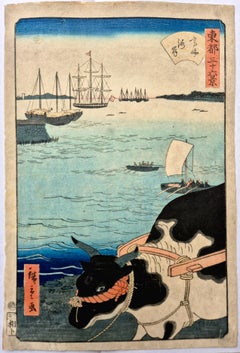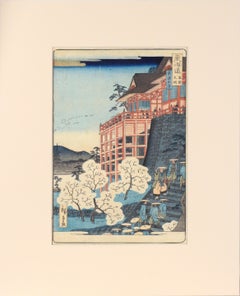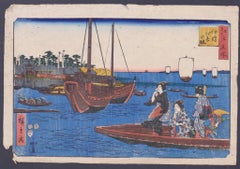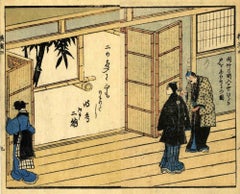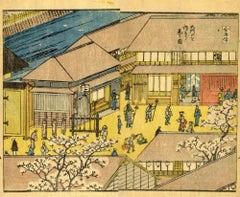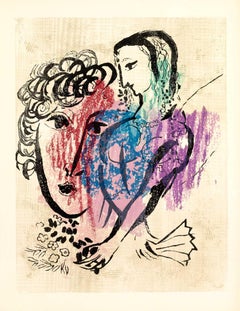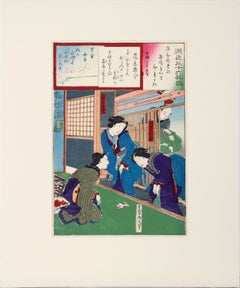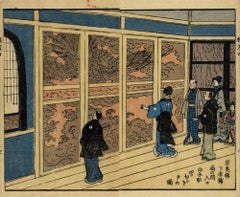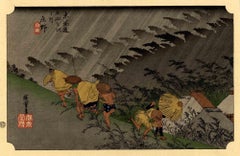Utagawa Hiroshige II Art
to
1
4
1
Overall Width
to
Overall Height
to
1
4
1
2
3
2
5
2
2
1
1
1
1
1
5
4
1
1
1
5
9,958
2,750
1,376
1,369
1
1
Artist: Utagawa Hiroshige II
Utagawa Hiroshige II -- The Beach at Takanawa
By Utagawa Hiroshige II
Located in BRUCE, ACT
Utagawa Hiroshige II
The Beach at Takanawa from Toto sanjurokkei 東都三十六景 (Thirty-six Views of the Eastern Capital), 1862
Woodblock
Oban
Signed Hiroshige ga and published by Sagamiya ...
Category
18th Century Utagawa Hiroshige II Art
Materials
Woodcut
Kiyomizu Temple, Scenes of Famous Places along Tôkaidô Road - Woodblock on Paper
By Utagawa Hiroshige II
Located in Soquel, CA
Kiyomizu Temple, Scenes of Famous Places along Tôkaidô Road - Woodblock on Paper
Full Title:
Kyoto: Kiyomizu Temple (Kyô Kiyomizudera), from the series Scenes of Famous Places along...
Category
1860s Edo Utagawa Hiroshige II Art
Materials
Ink, Rice Paper, Woodcut
Tsukuda Sumiyoshi no Yashiro - Woodcut by Hiroshige II - 1853
By Utagawa Hiroshige II
Located in Roma, IT
Tsukuda Sumiyoshi no yashiro (Sumiyoshi Shrine on Tsukuda Island) is the original title of this superb ten colour woodblock print on paper, by the Japanese master, Utagawa Hiroshige ...
Category
1850s Utagawa Hiroshige II Art
Materials
Woodcut, Paper
Bamboo Rooms in Iwahisa - Woodcut by Utagawa Hiroshige II - 1840s
By Utagawa Hiroshige II
Located in Roma, IT
Bamboo Rooms in Iwahisa is an original modern artwork realized by Utagawa Hiroshige II (1826 – 1869) in the 1840s.
Very good impression with reduced palette mainly in blue, green an...
Category
1840s Modern Utagawa Hiroshige II Art
Materials
Paper, Woodcut
Wandering Monks in the Courtyard of Konoura - Woodcut by U. Hiroshige II - 1840s
By Utagawa Hiroshige II
Located in Roma, IT
Wandering monks in the courtyard of Konoura is an original modern artwork realized by Utagawa Hiroshige II (1826 – 1869) in the 1840s.
Good impression with reduced palette mainly in...
Category
1840s Modern Utagawa Hiroshige II Art
Materials
Paper, Woodcut
Related Items
Pour ce Jour, 1968 (Poèmes, #7)
By Marc Chagall
Located in Greenwich, CT
Pour ce jour (For this Day) is a woodcut on paper from Marc Chagall's Poèmes portfolio, published in 1968. The image size is 13 x 10 inches and the art is framed in an ornate, gold-t...
Category
20th Century Modern Utagawa Hiroshige II Art
Materials
Paper, Woodcut
"Enshoku Sanju-roku Kasen" (Thirty-six Enchanting Flowers) Woodblock on paper
By Toyohara Kunichika
Located in Soquel, CA
"Enshoku Sanju-roku Kasen" (Thirty-six Enchanting Flowers) Woodblock on paper
Elegant woodblock print by Toyohara Kunuchika (Japanese, 1835-1900). Three women are in talking with each other inside, while a man waits outside holding a bag of some kind. The colors in this piece are rich and saturated, primarily blues, greens, and purple.
Mat size: 16"H x 20"W
Paper size: 14.75"H x 9.88"W
Born in 1835, Toyohara Kunichika grew up in the Kyobashi district of Edo in the midst of merchants and artisans. In 1848, at age 13, he was accepted as an apprentice into the studio of Utagawa Kunisada I...
Category
1880s Edo Utagawa Hiroshige II Art
Materials
Ink, Rice Paper, Woodcut
$380 Sale Price
20% Off
H 20 in W 16 in D 0.25 in
Kiyomi Barrier & Seiken Temple Near Okitsu- Japanese Woodcut Print on Rice Paper
By Utagawa Hiroshige
Located in Soquel, CA
Kiyomi Barrier & Seiken Temple Near Okitsu - Japanese Woodcut Print on Rice Paper
Woodblock print of boats in a harbor by Utagawa Hiroshige (Japanese, 1797-1858). Originally publish...
Category
1850s Impressionist Utagawa Hiroshige II Art
Materials
Rice Paper, Woodcut
$1,240 Sale Price
20% Off
H 15.5 in W 19.25 in D 1.25 in
Schwarze Madonna
Located in Wien, 9
Auguste Kronheim was born in Amsterdam in 1937. The artist makes woodcuts and drawings. She received her training in drawing from Hanns Kobinger and graduated from the Linz Federal T...
Category
20th Century Modern Utagawa Hiroshige II Art
Materials
Woodcut
Elwood W. Bartlett, Wisconsin Farm, about 1945, mid-century wood engraving
Located in New York, NY
Elwood Warren Bartlett is a Wisconsin native who also worked in Indiana.
Largely self taught as a printmaker, Bartlett worked in a style that once identified as his, immediately t...
Category
1940s American Modern Utagawa Hiroshige II Art
Materials
Woodcut
Rancho Woodcut Heart, 1982
By Jim Dine
Located in Palo Alto, CA
One of Jim Dine’s most iconic motifs, the romantic Rancho Woodcut Heart work illustrates the story of hope and love through a symbolic image of a large red heart. With the contrast o...
Category
1980s Modern Utagawa Hiroshige II Art
Materials
Woodcut
Madman's Drum (Brothel) — 'Story Without Words' Graphic Modernism
By Lynd Ward
Located in Myrtle Beach, SC
Lynd Ward, 'Madman's Drum, Plate 41', wood engraving, 1930, edition small. Signed in pencil. A fine, richly-inked impression, on off-white tissue-thin Japan paper; the full sheet with margins (1 5/8 to 2 1/2 inches); a small paper blemish in the upper right margin, away from the image, otherwise in excellent condition. A scarce, artist-printed, hand-signed proof impression before the published edition. Matted to museum standards, unframed.
Image size 5 1/2 x 3 3/4 inches (140 x 95 mm); sheet size 9 5/8 x 7 1/8 inches (244 x 181 mm).
From Lynd Ward’s book of illustrations without words, 'Madman’s Drum', Jonathan Cape and Harrison Smith, New York, 1930.
Reproduced in 'Storyteller Without Words, the Wood Engravings of Lynd Ward', Harry N. Abrams, New York, 1974.
ABOUT THE ARTIST
Lynd Ward is acknowledged as one of America’s foremost wood engravers and book illustrators of the first half of the twentieth century. His innovative use of narrative printmaking as a stand-alone storytelling vehicle was uniquely successful in reaching a broad audience. The powerful psychological intensity of his work, celebrated for its dynamic design, technical precision, and compelling dramatic content, finds resonance in the literature of Poe, Melville, and Hawthorne. Like these classic American writers, Ward was concerned with the themes of man’s inner struggles and the role of the subconscious in determining his destiny. An artist of social conscience during the Great Depression and World War II, he infused his graphic images with his unique brand of social realism, deftly portraying the problems that challenged the ideals of American society.
The son of a Methodist preacher, Lynd Ward, moved from Chicago to Massachusetts at an early age. He graduated from the Teachers College of Columbia University, New York, in 1926, where he studied illustration and graphic arts. He married May Yonge McNeer in 1936 and left for Europe for their honeymoon in Eastern Europe. After four months, they settled in Leipzig, where Ward studied at the National Academy of Graphic Arts and Bookmaking. Inspired by Belgian expressionist artist Frans Masereel's graphic novel ‘The Sun,’ and another graphic novel by the German artist Otto Nückel, ‘Destiny,’ he determined to create his own "wordless" novel. Upon his return to America, Ward completed his first book, ‘God's Man: A Novel in Woodcuts,’ published in 1929. ‘Gods’ Man’ was a great success for its author and publisher and was reprinted four times in 1930, including a British edition. This book and several which followed it, ‘Madman’s Drum,’ 1930, ‘Wild Pilgrimage...
Category
1930s American Modern Utagawa Hiroshige II Art
Materials
Woodcut
$650
H 5.07 in W 3 in D 0.01 in
Wedding Party
Located in Buffalo, NY
An original mid century modern woodblock print.
This work is hand signed illegibly and titled "Wedding Party".
Category
1960s Modern Utagawa Hiroshige II Art
Materials
Paper, Woodcut
Edo Landscape Japanese Woodblock Print
By Utagawa Hiroshige (Ando Hiroshige)
Located in Houston, TX
Edo Meisho woodblock print of a famous Japanese coastal dock. This woodblock is most likely apart of the series "One Hundred Famous Views of Edo." The woodblock print is printed on r...
Category
1850s Edo Utagawa Hiroshige II Art
Materials
Woodcut
$1,500
H 10 in W 15 in D 0.004 in
One Hundred Aspects of the Moon, Mt Otawa Moon - Bright God Tamura
By Tsukioka Yoshitoshi
Located in Soquel, CA
"Mount Otawa Moon: Bright God Tamura" - Woodblock on Paper by Tsukioka Yoshitoshi
From the series "One Hundred Aspects of the Moon"
This piece depicts the general Sakanoe no Tamura...
Category
1880s Edo Utagawa Hiroshige II Art
Materials
Paper, Ink, Woodcut
$600 Sale Price
20% Off
H 20.5 in W 15.5 in D 0.75 in
Stevan Dohanos, Backyard
By Stevan Dohanos
Located in New York, NY
Stevan Dohanos was an accomplished draftsman who work was widely known through the Saturday Evening Post. This print 'Backyard,' however, leaves aside the illustrative magazine work ...
Category
1930s American Modern Utagawa Hiroshige II Art
Materials
Woodcut
Werner Drewes, Winter, 1933, modernist woodcut
By Werner Drewes
Located in New York, NY
A modernist fantasy winter scene created by Werner Drewes, this print brings key aspects of the period together. His cubist-inspired woodcut technique is utilized here to bring the s...
Category
1930s American Modern Utagawa Hiroshige II Art
Materials
Woodcut
Previously Available Items
Dragon Room in Iwahisa - Original Woodcut by Utagawa Hiroshige II - 1840s
By Utagawa Hiroshige II
Located in Roma, IT
Dragon Room in Iwahisa is an original modern artwork realized by Utagawa Hiroshige II (1826 – 1869) in the 1840s.
Good impression with reduced palette mainly in blue, green and yell...
Category
1840s Modern Utagawa Hiroshige II Art
Materials
Paper, Woodcut
Utagawa Hiroshige IIDragon Room in Iwahisa - Original Woodcut by Utagawa Hiroshige II - 1840s, 1840s
H 7.88 in W 11.82 in D 0.04 in
Meishoe - Original Woodcut by Utagawa Hiroshige II - 1830s
By Utagawa Hiroshige II
Located in Roma, IT
Meishoe is an original modern artwork realized by Utagawa Hiroshige II (1826 – 1869) in the 1830s..
Oban Yoko-e.
From the famous Tokaido series of 1833, the most famous print of th...
Category
1830s Modern Utagawa Hiroshige II Art
Materials
Paper, Woodcut
H 10.01 in W 14.97 in D 0.04 in
Catching Fireflies by the Uji River in Yamashiro Province
By Utagawa Hiroshige II
Located in Fairlawn, OH
Hiroshige ga, Toyokuni ga in toshidama cartouche;
Censor's seal: Chicken 8 aratame;
Blockcutter's mark: Horikô Mino, center sheet only, (Japanese, 1833-1906)
and Utagawa Ku...
Category
Mid-19th Century Utagawa Hiroshige II Art
Materials
Woodcut
Utagawa Hiroshige Ii art for sale on 1stDibs.
Find a wide variety of authentic Utagawa Hiroshige II art available for sale on 1stDibs. You can also browse by medium to find art by Utagawa Hiroshige II in paper, woodcut print and more. Much of the original work by this artist or collective was created during the 19th century and is mostly associated with the modern style. Not every interior allows for large Utagawa Hiroshige II art, so small editions measuring 9 inches across are available. Customers who are interested in this artist might also find the work of Utagawa Yoshitora, Keisei Eisen, and Kaoru Kawano. Utagawa Hiroshige II art prices can differ depending upon medium, time period and other attributes. On 1stDibs, the price for these items starts at $334 and tops out at $1,563, while the average work can sell for $718.
